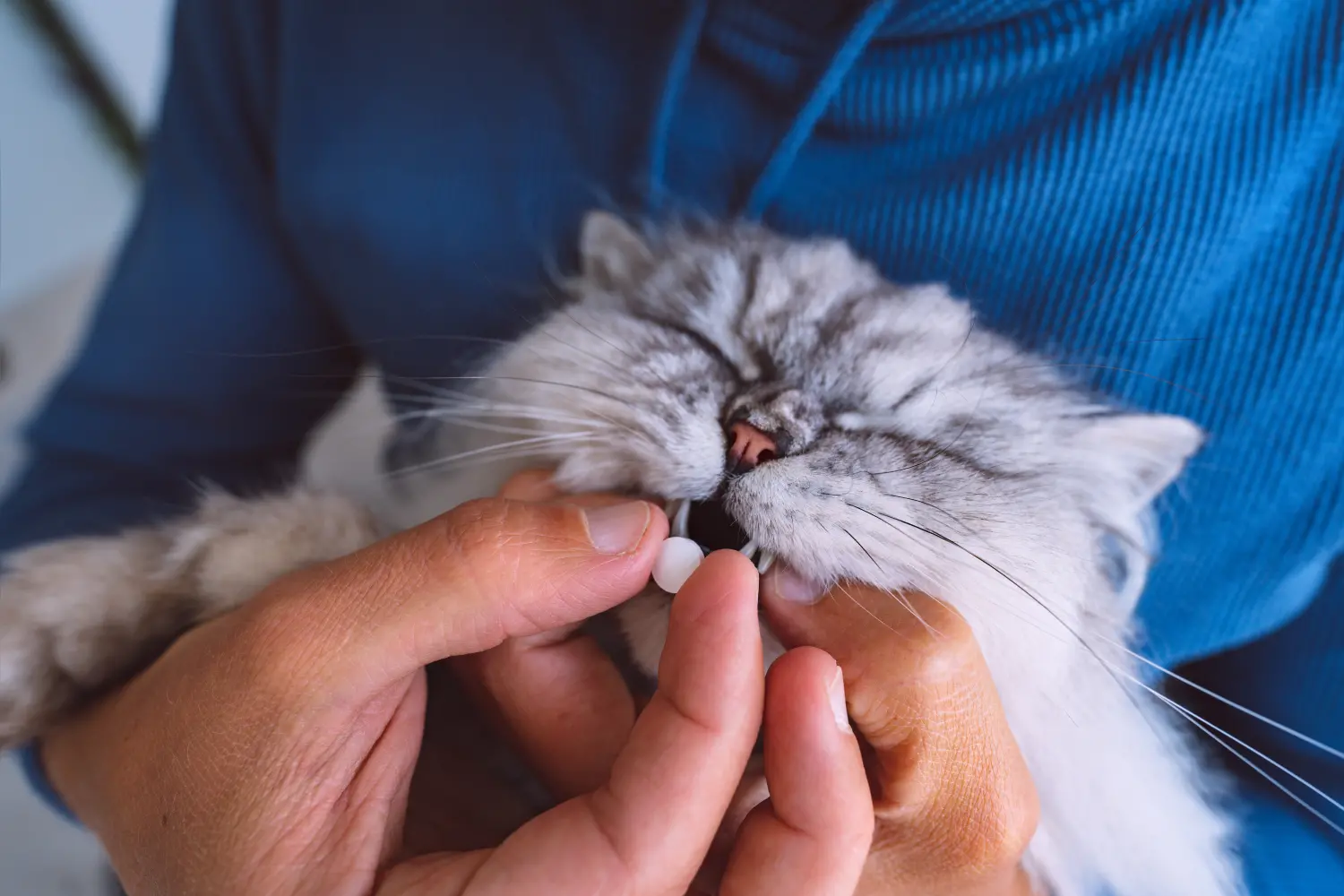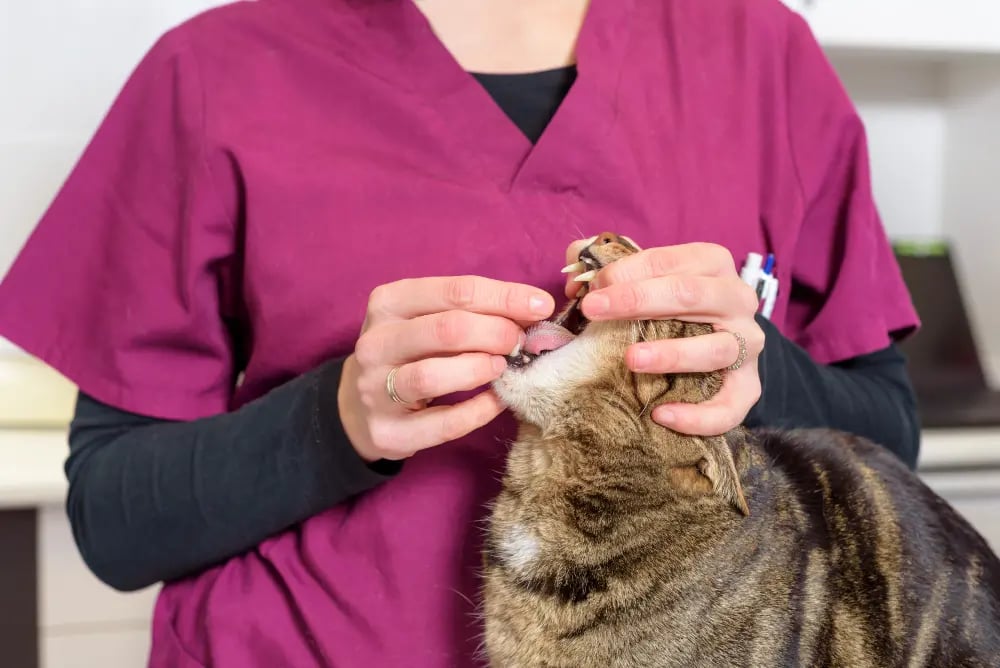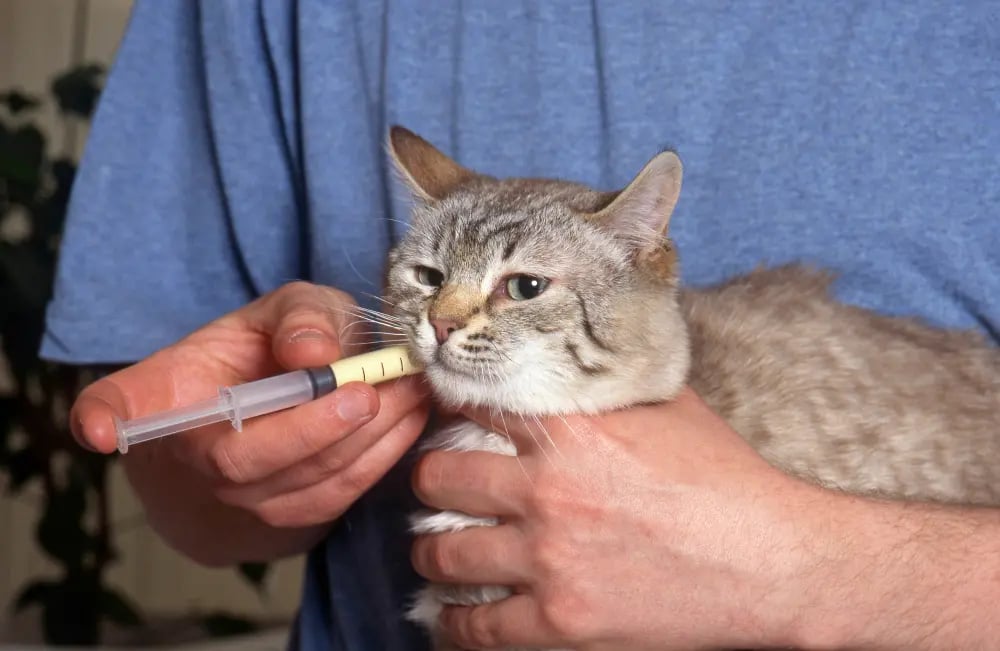
Medicating a cat can be stressful, especially if your cat is less than cooperative. Check out these purr-fect techniques for how to pill a cat and tips for stress-free medication administration.
So, your kitty isn’t feeling well, or maybe your furry friend requires a dose of medication. It’s never easy to pill a cat. In fact, you might be putting your life and limbs in jeopardy because many felines will fight tooth and nail to avoid what they consider an unpleasant process.
Giving a pill to a cat is a challenging task for many cat owners, but it is essential for administering medication and maintaining your feline friend's health.
Easiest Way to Give a Cat a Pill
In this guide, we will explore some helpful tips and techniques to make the process of pilling your cat as stress-free and successful as possible (we will even explore how to give cat liquid medication).
Remember, patience and a gentle approach are key when it comes to medicating your beloved cat. If you remain calm, then your cat is less likely to get stressed and freak out.
Supplies for Giving a Cat a Pill
If you've never had to give a cat a pill before, you might be surprised by how difficult it can be for some cats. The right supplies to give a cat a pill can make the whole process less complicated, less frustrating, and more safe.
Before you get started, gather up all the supplies you might need.
- Cat Medication: The prescribed pill or capsule provided by your veterinarian for your cat's specific condition.
- Cat Treats or Soft Food: Something your cat enjoys, which can be used as a treat to reward them after taking the medication. This helps create a positive association with the process. At Homes Alive Pets, we offer a wide array of cat treats.
- Pill Pockets (Optional): Commercially available treat pill pockets are designed to hide the pill, making it easier to administer. Check out Greenies Feline Pill Pockets.
- Towel or Blanket: A soft towel or blanket can be used to wrap your cat gently, helping to secure them during the process.
- Water: Have a bowl of water nearby to help your cat swallow the pill more easily.
- Pestle and Mortar (If Required): If the pill needs to be crushed or mixed with food, a pestle and mortar can be helpful.
- Gloves (Optional): Wearing gloves can protect your hands from potential scratches, especially if your cat is particularly resistant. When afraid, most cats will not hesitate to use their teeth or claws to fight back.
Step 1: Prepare the Medication and Gather Supplies
Let’s explore the best way to give a cat a pill. Giving a cat a pill doesn’t have to be a rodeo if you do it correctly.
Always follow your veterinarian's instructions when administering medication to your cat, and if you have any doubts or concerns, consult your vet for guidance. It is essential to approach the process with patience and gentleness, ensuring a positive experience for both you and your feline companion.
Before attempting to pill your cat, gather the necessary supplies ready:
- Medication, prepared and properly dosed
- Soft or flavourful treats to reward
- A towel or small blanket
Make sure everything you need is within arms reach of where you plan to give your cat the medicaiton. The quicker the process, the less stressful it will be for both of you.
Step 2: Choose the Right Time and Location
When pilling a cat, selecting the appropriate time and location is crucial to reduce stress and distractions. Find a quiet and calm area where your cat feels comfortable, such as a familiar room or a secluded corner.
Also, timing is essential. If possible, choose a time when your cat is relaxed and not too active, which may vary depending on your cat's individual schedule.
A serene environment will improve your chances of successfully administering the pill with minimal resistance from your feline companion.
Step 3: Familiarize Your Cat with Handling
Before attempting to pill your cat, it's essential to familiarize them with gentle handling to build trust and reduce anxiety.
Start by spending time petting and stroking your cat in a relaxed manner, paying attention to areas around the mouth and head. Use a soft, reassuring tone of voice to create a calming atmosphere.
Introduce your cat to the sensation of opening their mouth by gently lifting their lips and touching their teeth and gums.
Reward them with treats or positive reinforcement during and after each handling session, encouraging them to associate these interactions with positive experiences.
Remember to be patient and go at your cat's pace, allowing them to feel comfortable and secure throughout the training process.
Step 4: Positioning and Administering the Pill

With the pill prepared and your cat comfortable, it's time to proceed with the actual administration. Here's how to position and give the pill to your cat:
- Secure your cat: If your cat is calm and cooperative, gently place them on a stable surface, like a table or your lap, facing away from you. Use a towel or blanket to wrap them snugly, leaving their head exposed. This wrapping technique will help keep your cat restrained while minimizing movement during the process.
- Hold the pill: Using your dominant hand, hold the prepared pill between your thumb and index finger. Make sure it is easily accessible and ready for swift administration.
- Position your hand: With your non-dominant hand, place your palm over your cat's head with your middle finger and thumb on opposite sides of your cat's top jaw.
- Open the mouth: Apply gentle pressure on the top jaw while slowly tilting your cat's head back. Use the middle finger of the hand that is holding the pill to gently press down on your cat's bottom jaw to open their mouth.
- Place the pill: Once your cat's mouth is open, quickly and carefully insert the pill as far back on the tongue as possible. Avoid the front of the mouth, as your cat may be more likely to spit it out if it's not too far back.
- Encourage swallowing: Close your cat's mouth gently and hold it closed while maintaining a slightly elevated head position. Rub your cat's throat gently in a downward motion to encourage swallowing.
- Offer a treat: After administering the pill, offer your cat a treat or a small amount of their favourite soft food immediately. This positive reinforcement will help create a positive association with the process.
Check out this quick video to see the method in practice:
It’s important that you stay calm and patient throughout the process of pilling the cat and be prepared for the possibility that your feline may resist or spit out the pill. If this happens, do not force it or attempt to give another pill immediately.
Allow some time to pass before trying again, or consult your veterinarian for alternative methods of medication administration.
Using a Pill Giver When Giving a Cat a Pill
Some pet parents opt to use a pill giver when trying to figure out how to get a cat to swallow a pill.
A pill giver, also known as a pill dispenser or pill gun, is a device designed to assist pet owners in administering pills or tablets to their pets, particularly cats.
Pill givers are useful for pet owners who find it challenging to give pills to their pets using their hands or fingers. If your cat tries to bite you when you put the pill in the cat’s mouth, then a pill giver is a fantastic way to save your fingers from sharp teeth!
The device allows for precise placement of the pill in the back of the pet's mouth, making the process easier and less stressful for both the pet and the owner.
Step 5: Alternative Medication Administration
Giving cats pills can be challenging, and if your cat is having none of it, then you may need to consider a different approach.
Talk to your vet about alternative medication formats. Chewable pills or liquid formats might be available that will be easier to administer, or you may be able to hide the pill in some food.
Chewable Pills
Chewable options are often flavoured like a treat, and most cats will voluntarily eat the medication. However, not all medications are not offered in this format.
Liquid Medication
Liquid medications are more common and may be an easier choice for a cat that refuses to swallow a pill. It can be administered in a small syringe. Check out the tips below to learn more about administering liquid medications.
Crushed Pills
If pills are your only choice, ask your vet if the pill can be crushed and mixed with food. Then you can use a pestle and mortar to crush it into a fine powder. Mix the crushed pill with a small amount of your cat's favourite wet food to mask the medication's taste and texture.
Pill Treats
Lastly, consider purchasing a treat designed to hide pills, like a pill pocket. Gently insert the pill into the pocket and pinch the ends closed, ensuring it is entirely covered. The tasty treat can then be fed to your unsuspecting cat.
How to Give a Cat Liquid Medicine

We’ve covered how to give a cat a pill; now, let’s look at how to give a cat liquid medication.
Giving a cat liquid medicine requires a little patience and gentleness, but it can be a little easier than giving your cat a pill.
To give liquid medicine to a cat, you will need a syringe. Usually, the veterinarian or the pharmacy will provide you with an appropriate syringe to administer the medication.
To administer liquid medicine to your cat, start by preparing the prescribed medication, shaking the liquid well before use, and following the dosage instructions provided by your veterinarian.
-
- Have a syringe or dropper ready to measure and administer the liquid accurately.
- Choose a quiet and comfortable area where your cat feels secure, and if necessary, gently wrap them in a soft towel or blanket to keep them calm and prevent sudden movements.
- Position your cat on a table or your lap, facing away from you, and gently tilt their head backward while keeping it slightly elevated. This position facilitates the process and helps prevent choking.
- With the syringe or dropper, place the liquid medicine into the side of their mouth, between the cheek and teeth. You want the liquid to enter as far back in their mouth as you can.
- Administer the medicine slowly, allowing your cat to swallow at their own pace to prevent aspiration.
Throughout the process, maintain a positive and soothing tone of voice, reassuring your cat and keeping them as relaxed as possible.
After giving the liquid medicine, offer a treat or some tasty wet food as a reward for their cooperation. Make sure that the medication can be taken with food. Otherwise, grab a toy or give your cat some cuddles.
Many pet owners want to learn how to give a cat a pill with a syringe, but giving a cat a pill with a syringe may not be the most common method of medication administration. When using a syringe, it is typically only for liquid medications rather than as a way to give a cat a pill.
Frequently Asked Questions About Pilling a Cat
My cat refuses to take the pill no matter what I try. What should I do?
If your cat consistently resists taking the pill, don't force it. Consult your veterinarian for alternative medication options, such as a different form of the drug (liquid, chewable), or inquire about compounding the medication into a more palatable form.
Can I hide the pill in my cat's regular food?
Some cats are skilled at detecting pills in their food and may avoid eating the capsule altogether. However, you can try using pill pockets or mixing crushed pills (ask your vet first) with a small amount of strong-smelling and tasty wet food to mask the medication.
Is it safe to crush the pill and mix it with food?
Crushing a pill may alter its efficacy or cause unintended side effects. Always consult your veterinarian before crushing a pill, as not all medications can be administered this way.
My cat spits out the pill as soon as I give it to them. Any tips to prevent this?
Placing the pill as far back on the tongue as possible may reduce the likelihood of your cat spitting it out. Additionally, gently holding their mouth closed and tilted up can encourage them to swallow the pill.
My cat scratched me while trying to pill them. How can I avoid this in the future?
Wear gloves during the pilling process to protect your hands from scratches. If your cat becomes too agitated or aggressive, consider wrapping them in a towel or blanket to minimize the risk of injury.
What should I do if my cat regurgitates the pill after swallowing it?
If your cat vomits the pill shortly after administration, contact your veterinarian for further instructions. They may advise re-administering the medication or recommend a different dosage form or medication altogether.
.png?width=200&height=66&name=logo%20(1).png)

